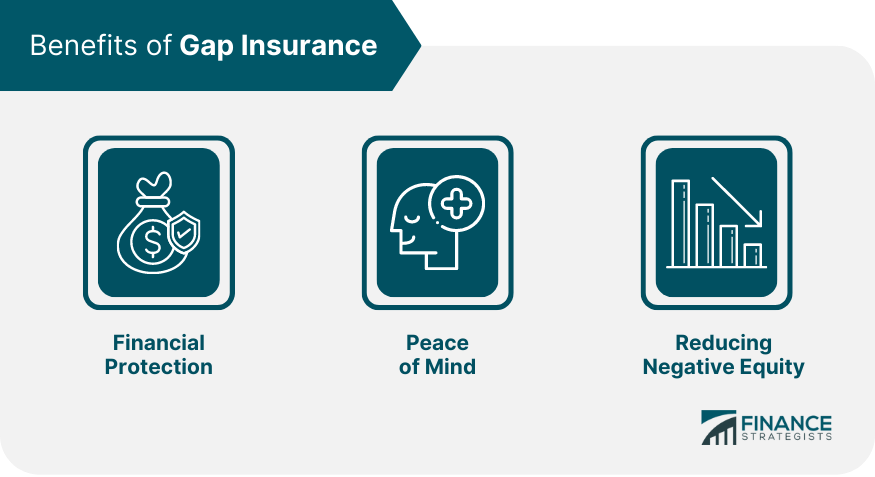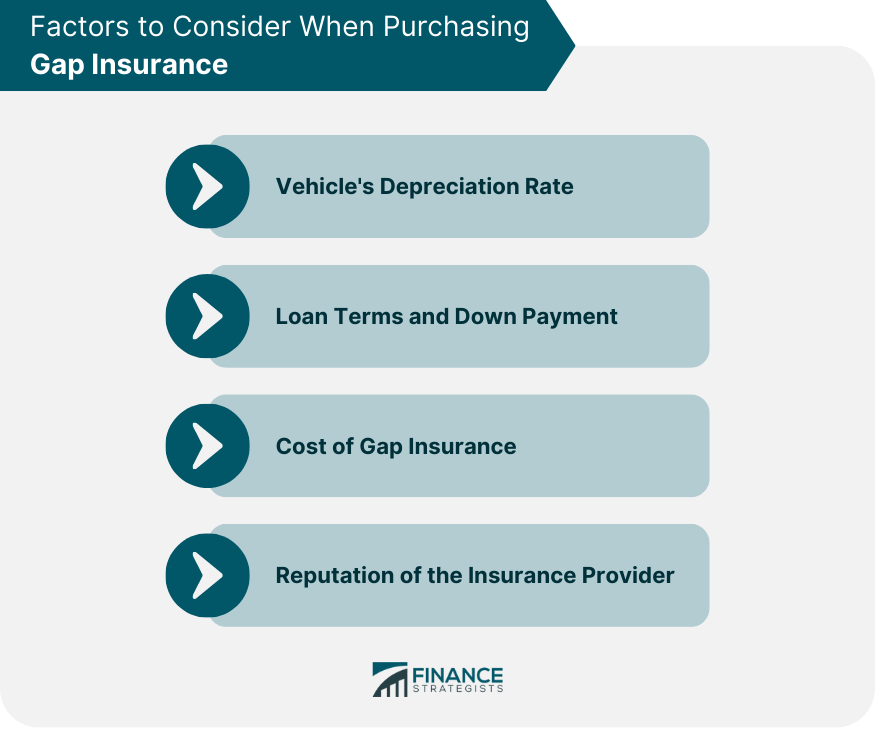Gap insurance, also known as Guaranteed Asset Protection, is a specialized insurance product designed to cover the difference between the outstanding loan balance on a vehicle and its current market value. This type of insurance is particularly important for individuals who finance or lease their vehicles, as it can provide financial protection in the event of an accident, theft, or other incidents resulting in a total loss. Gap insurance is an optional insurance coverage that helps protect vehicle owners from financial losses that may occur if their vehicle is totaled or stolen, and they owe more on their loan or lease than the vehicle's actual cash value. It covers the "gap" between what is owed on the vehicle and its current market value, providing the policyholder with peace of mind and additional financial protection. The primary purpose of gap insurance is to protect individuals from the financial burden that can arise when their vehicle's value depreciates faster than the outstanding loan balance. This can occur due to various factors such as rapid depreciation, high financing amounts, or extended loan terms. Gap insurance is especially important for individuals who lease or finance their vehicles, as it can help protect them from financial losses in case of total loss events. Gap insurance comes into play in specific situations, such as when a vehicle experiences significant depreciation or when a financed vehicle is totaled in an accident. Understanding the coverage and exclusions is essential to maximize the benefits of gap insurance. New vehicles typically experience rapid depreciation, with their value decreasing significantly within the first few years of ownership. In some cases, this can result in a situation where the vehicle's market value is less than the remaining loan balance. Gap insurance can help cover the difference in these situations, providing financial protection for the policyholder. Leasing and financing agreements often involve low down payments and extended loan terms, resulting in higher outstanding loan balances. In the event of a total loss, the insurance company will typically only pay the current market value of the vehicle, leaving the policyholder responsible for the remaining balance. Gap insurance can help cover this difference, protecting the policyholder from financial losses. Gap insurance typically works in conjunction with comprehensive insurance coverage, which covers incidents such as theft, vandalism, and natural disasters. In the event of a total loss covered by comprehensive insurance, gap insurance can help cover the difference between the outstanding loan balance and the vehicle's market value. Collision coverage is another essential component of gap insurance, as it covers damage to the vehicle resulting from an accident, regardless of fault. If the vehicle is deemed a total loss due to a collision, gap insurance can help cover the difference between the loan balance and the vehicle's market value. It is essential to note that gap insurance only comes into play when the vehicle is deemed a total loss by the insurance company. This means that the cost of repairing the vehicle would exceed its current market value, or the vehicle is deemed non-repairable due to extensive damage. In cases where the vehicle can be repaired, gap insurance will not provide any coverage. Gap insurance offers several benefits to policyholders, including financial protection, peace of mind, and reducing negative equity. The primary benefit of gap insurance is the financial protection it provides to policyholders. In the event of a total loss, gap insurance can help cover the difference between the outstanding loan balance and the vehicle's market value, preventing the policyholder from being saddled with a substantial financial burden. For individuals who lease or finance their vehicles, gap insurance can provide peace of mind, knowing that they are protected from potential financial losses if their vehicle is deemed a total loss. This additional coverage can help alleviate the stress associated with accidents or thefts, allowing policyholders to focus on recovering from the incident rather than worrying about the financial implications. Negative equity occurs when the outstanding loan balance on a vehicle exceeds its current market value. Gap insurance can help reduce the impact of negative equity by covering the difference between the loan balance and the vehicle's market value in the event of a total loss. This can be especially beneficial for individuals with high loan balances or extended loan terms, as it helps protect their financial interests. There are several types of providers offering gap insurance, including auto insurance companies, auto dealers and lenders, and standalone gap insurance providers. Many auto insurance companies offer gap insurance as an add-on to their existing policies. Purchasing gap insurance through your auto insurance provider can be a convenient option, as it allows you to manage all of your insurance needs in one place. However, it is essential to compare the cost and coverage offered by different providers to ensure you are getting the best value for your money. Auto dealers and lenders often offer gap insurance to customers when they lease or finance a vehicle. While this can be a convenient option, it is essential to be cautious, as the cost of gap insurance may be higher through a dealer or lender than through an insurance company. It is always a good idea to shop around and compare prices before committing to a specific provider. Standalone gap insurance providers specialize in offering gap insurance coverage separate from standard auto insurance policies. These providers can often offer competitive pricing and tailored coverage options. However, it is crucial to research the reputation of the provider and carefully review the terms and conditions of the policy before purchasing. There are several factors to consider when purchasing gap insurance, including the vehicle's depreciation rate, loan terms and down payment, the cost of gap insurance, and the reputation of the insurance provider. The depreciation rate of your vehicle can significantly impact the need for gap insurance. Vehicles with higher depreciation rates are more likely to experience a gap between the outstanding loan balance and the vehicle's market value, making gap insurance more valuable. Researching the expected depreciation rate of your vehicle can help you determine if gap insurance is a worthwhile investment. The terms of your loan, such as the interest rate and loan duration, can also impact the need for gap insurance. Longer loan terms and smaller down payments can result in higher outstanding loan balances, increasing the likelihood of needing gap insurance. Evaluating your loan terms and down payment can help you decide if gap insurance is necessary for your situation. The cost of gap insurance can vary significantly between providers, so it is essential to shop around and compare prices before making a decision. Be sure to consider both the premium and any deductibles associated with the policy, as well as the level of coverage provided. Lastly, it is crucial to research the reputation of the insurance provider before purchasing a gap insurance policy. Look for reviews and testimonials from other customers, as well as any complaints or legal actions against the provider. Ensuring that you are working with a reputable provider can help prevent potential issues down the line. In the event that you need to make a gap insurance claim, there are several steps to follow, including reporting the incident, providing documentation and proof of loss, and working with the insurance company's assessment and settlement process. The first step in making a gap insurance claim is to report the incident to both your primary auto insurance provider and your gap insurance provider. This should be done as soon as possible after the event occurs. Be prepared to provide details about the incident, such as the date, location, and a description of what happened. After reporting the incident, you will likely be asked to provide documentation and proof of loss to support your claim. This may include police reports, photos of the damaged vehicle, repair estimates, and any other relevant documentation. It's essential to keep organized records of all documents related to the claim to help expedite the process. Once the necessary documentation has been submitted, the insurance company will assess your claim to determine if it qualifies for gap insurance coverage. This may involve verifying the details of the incident, assessing the value of the vehicle at the time of the total loss, and determining the outstanding loan balance. If the claim is approved, the insurance company will pay the difference between the outstanding loan balance and the vehicle's market value directly to the lender, effectively settling the gap. Gap insurance serves as a valuable financial safeguard for individuals who lease or finance their vehicles, shielding them from potential financial strain in the event of a total loss. By understanding the key aspects of gap insurance, including its purpose, benefits, and coverage options, vehicle owners can make informed decisions about whether this type of insurance is suitable for their needs. Factors such as vehicle depreciation rate, loan terms, cost of insurance, and the reputation of the provider should be carefully considered before purchasing a policy. In case of a total loss, having gap insurance in place can offer peace of mind and financial protection, enabling policyholders to focus on recovery rather than the financial consequences of the incident. Through a thorough understanding of the claim process and maintaining organized records, policyholders can ensure a smoother and more efficient settlement. Ultimately, gap insurance is an essential consideration for those who want to protect themselves from potential financial risks associated with the gap between a vehicle's market value and its outstanding loan balance.What Is Gap Insurance?
How Gap Insurance Works
Situations Where Gap Insurance is Applicable
Vehicle Depreciation
Leasing and Financing
Coverage and Exclusions
Comprehensive Coverage
Collision Coverage
Total Loss
Benefits of Gap Insurance
Financial Protection
Peace of Mind
Reducing Negative Equity

Gap Insurance Providers
Auto Insurance Companies
Auto Dealers and Lenders
Standalone Gap Insurance Providers
Factors to Consider When Purchasing Gap Insurance
Vehicle's Depreciation Rate
Loan Terms and Down Payment
Cost of Gap Insurance
Reputation of the Insurance Provider

How to Make a Gap Insurance Claim
Reporting the Incident
Providing Documentation and Proof of Loss
Insurance Company Assessment and Settlement Process
Final Thoughts
Gap Insurance FAQs
Gap insurance is a type of insurance policy that covers the difference between the actual cash value of a vehicle and the outstanding balance on a loan or lease in case of a total loss or theft.
Gap insurance is typically recommended for those who lease a vehicle or those who have a loan on a vehicle with a high interest rate or a long loan term, as they are more likely to owe more than the vehicle is worth.
If a vehicle is totaled or stolen, the insurance company will typically pay the actual cash value of the vehicle, which may be less than the outstanding balance on the loan or lease. Gap insurance will cover the difference between the actual cash value and the outstanding balance, up to the policy limit.
Gap insurance covers the difference between the actual cash value of a vehicle and the outstanding balance on a loan or lease. It does not cover any damages to the vehicle, injuries or other types of insurance coverage.
Gap insurance can be purchased from an insurance company, car dealership or finance company. It is also possible to add gap insurance as an endorsement to an existing auto insurance policy.
True Tamplin is a published author, public speaker, CEO of UpDigital, and founder of Finance Strategists.
True is a Certified Educator in Personal Finance (CEPF®), author of The Handy Financial Ratios Guide, a member of the Society for Advancing Business Editing and Writing, contributes to his financial education site, Finance Strategists, and has spoken to various financial communities such as the CFA Institute, as well as university students like his Alma mater, Biola University, where he received a bachelor of science in business and data analytics.
To learn more about True, visit his personal website or view his author profiles on Amazon, Nasdaq and Forbes.











